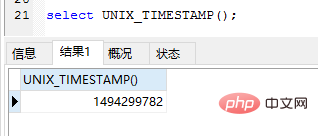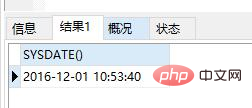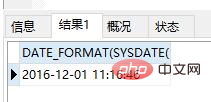Summary of date and time types and formatting methods in MySQL
This article brings you relevant knowledge about mysql. It mainly introduces the date and time types and formatting methods in MySQL. Several commonly used time types in MySQL are: date, datetime , time, year, timestamp, let’s take a look at it, I hope it will be helpful to everyone.

Recommended learning: mysql video tutorial
[1] Date and time types in MySQL
MySQL Several commonly used time types are: date, datetime, time, year, timestamp
| Data type | Occupies the smallest number of bytes | Value | Maximum value | A zero value means |
|---|---|---|---|---|
| date | 4 | 1000-01-01 | 9999-12-31 | 0000-00-00 |
| datetime | 8 | 1000-01-01 00:00:00 | 9999-12-31 23:59:59 | 0000-00-00 00:00: 00 |
| timestamp | 4 | 19700101080001 | Sometime in 2038 | 0000000000000000 |
| time | 3 | -838:59:59 | 838:59:59 | 00:00:00 |
| year | 1 | 1901 | 2155 | 0000 |
Detailed explanation
-
datetime: Time date type, the format is YYYY-mm-dd HH: ii:ss, the range is from 1000 to 9999. But there is a zero value, 0000-00-00 00:00:00; -
date: Date is the date part of datetime; -
time: Time (segment), between a specified interval, from - time to time (represented by negative time); -
timestamp: Timestamp, not a conventional time Stamp (such as: 14253685), the range is '1970-01-01 00:00:00' to 2037. The format is YYYY-mm-dd HH:ii:ss, The format is completely consistent with datetime; -
year: yy and yyyy, the range of yyyy is 1901-2155 , the range of yy is 1970-2069.
Two-digit year (00-69 means 2000-2069, 70-99 means 1970~1999). When the application only needs to record the year, year saves more space than date
SQL statement example
create table my_date( d1 datetime, d2 date, d3 time, d4 timestamp, d5 year )charset utf8; desc my_date
As shown in the figure below: year defaults to 4 digits, that is, YYYY; timestamp cannot be empty, and there is The default value is to refresh this data column when creating new records and modifying existing records.

Insert several pieces of data as follows and do a difference analysis on time:
insert into my_date VALUES('2015-09-28 11:50:36','2015-09-28','11:50:54','2015-09-28 11:51:08','2015'); insert into my_date VALUES('2015-09-28 11:50:36','2015-09-28','-11:50:54','2015-09-28 11:51:08','2015');-- -11 insert into my_date VALUES('2015-09-28 11:50:36','2015-09-28','-211:50:54','2015-09-28 11:51:08','2015');-- -2 11 insert into my_date VALUES('2015-09-28 11:50:36','2015-09-28','-2 11:50:54','2015-09-28 11:51:08','2015');-- -2过去两天 #year用69标识-2069 insert into my_date VALUES('2015-09-28 11:50:36','2015-09-28','11:50:54','2015-09-28 11:51:08','69');-- 69 #year用70标识-1970 insert into my_date VALUES('2015-09-28 11:50:36','2015-09-28','11:50:54','2015-09-28 11:51:08','70');-- 70


timestamp field
By default, as long as the current record is updated, this field will be automatically updated to the current time.
update my_date set d1 = SYSDATE() where d5=69; select * from my_date

So can MySQL get the real timestamp? sure!
select UNIX_TIMESTAMP();

Test Example
4.1 Query the current time
SELECT SYSDATE() from dual;

4.2 Insert the current time into the above types of columns
insert INTO `user` (name,number,date,datetime,timestamp,time,year) VALUES ( 'Loum',3,SYSDATE(),SYSDATE(),SYSDATE(),SYSDATE(),2016 );

4.3 The length bit of datetime type in mysql The number
is as follows. Usually the length of the datetime type in our MySQL is designed to be 0 by default:
`work_time` datetime(0) DEFAULT NULL COMMENT '清收时间',
At this time, the insertion time is usually what we often see: 2020-08- 29 12:52:16 format. But what if n in datetime(n) is not 0?
`work_time` datetime(2) DEFAULT NULL COMMENT '清收时间', # datetime(n)中的n最大值为6 `work_time` datetime(6) DEFAULT NULL COMMENT '清收时间',
At this time, it will be displayed as follows in MySQL:
2020-08-29 12:52:16.01
2020-08-29 12:52:16.014057
You will find that there is a decimal point at the end and the numbers after the decimal point will correspond to the corresponding digits - this is called nanoseconds.
The summary is as follows:
date: only date, no time;datetime: With time and date;time: Only time, accurate to minutes and seconds;timestamp: Timestamp, accurate to minutes Seconds;year: year, such as 2002, if written as 2002-01-15, calculation will be performed, and the inserted result will be 1986
[2 】Date time type formatting
DATE_FORMAT( ) function
You can use the date_format( ) function to convert time.
SELECT DATE_FORMAT(SYSDATE(),'%Y-%m-%d %H:%i:%s') from dual;

date_format( ) 转换格式
| 格式 | 描述 |
|---|---|
| %a | 缩写星期名 |
| %b | 缩写月名 |
| %c | 月,数值 |
| %D | 带有英文前缀的月中的天 |
| %d | 月的天,数值(00-31) |
| %e | 月的天,数值(0-31) |
| %f | 微秒 |
| %H | 小时 (00-23) |
| %h | 小时 (01-12) |
| %I | 小时 (01-12) |
| %i | 分钟,数值(00-59) |
| %j | 年的天 (001-366) |
| %k | 小时 (0-23) |
| %l | 小时 (1-12) |
| %M | 月名 |
| %m | 月,数值(00-12) |
| %p | AM 或 PM |
| %r | 时间,12-小时(hh:mm:ss AM 或 PM) |
| %S | 秒(00-59) |
| %s | 秒(00-59) |
| %T | 时间, 24-小时 (hh:mm:ss) |
| %U | 周 (00-53) 星期日是一周的第一天 |
| %u | 周 (00-53) 星期一是一周的第一天 |
| %V | 周 (01-53) 星期日是一周的第一天,与 %X 使用 |
| %v | 周 (01-53) 星期一是一周的第一天,与 %x 使用 |
| %W | 星期名 |
| %w | 周的天 (0=星期日, 6=星期六) |
| %X | 年,其中的星期日是周的第一天,4 位,与 %V 使用 |
| %x | 年,其中的星期一是周的第一天,4 位,与 %v 使用 |
| %Y | 年,4 位 |
| %y | 年,2 位 |
str_to_date()函数
字符串转换为date:
str_to_date( '2016-12-15 16:48:40', '%Y-%m-%d %H:%i:%S' )
推荐学习:mysql视频教程
The above is the detailed content of Summary of date and time types and formatting methods in MySQL. For more information, please follow other related articles on the PHP Chinese website!

Hot AI Tools

Undresser.AI Undress
AI-powered app for creating realistic nude photos

AI Clothes Remover
Online AI tool for removing clothes from photos.

Undress AI Tool
Undress images for free

Clothoff.io
AI clothes remover

Video Face Swap
Swap faces in any video effortlessly with our completely free AI face swap tool!

Hot Article

Hot Tools

Notepad++7.3.1
Easy-to-use and free code editor

SublimeText3 Chinese version
Chinese version, very easy to use

Zend Studio 13.0.1
Powerful PHP integrated development environment

Dreamweaver CS6
Visual web development tools

SublimeText3 Mac version
God-level code editing software (SublimeText3)

Hot Topics
 1392
1392
 52
52
 How to open phpmyadmin
Apr 10, 2025 pm 10:51 PM
How to open phpmyadmin
Apr 10, 2025 pm 10:51 PM
You can open phpMyAdmin through the following steps: 1. Log in to the website control panel; 2. Find and click the phpMyAdmin icon; 3. Enter MySQL credentials; 4. Click "Login".
 MySQL: An Introduction to the World's Most Popular Database
Apr 12, 2025 am 12:18 AM
MySQL: An Introduction to the World's Most Popular Database
Apr 12, 2025 am 12:18 AM
MySQL is an open source relational database management system, mainly used to store and retrieve data quickly and reliably. Its working principle includes client requests, query resolution, execution of queries and return results. Examples of usage include creating tables, inserting and querying data, and advanced features such as JOIN operations. Common errors involve SQL syntax, data types, and permissions, and optimization suggestions include the use of indexes, optimized queries, and partitioning of tables.
 How to use single threaded redis
Apr 10, 2025 pm 07:12 PM
How to use single threaded redis
Apr 10, 2025 pm 07:12 PM
Redis uses a single threaded architecture to provide high performance, simplicity, and consistency. It utilizes I/O multiplexing, event loops, non-blocking I/O, and shared memory to improve concurrency, but with limitations of concurrency limitations, single point of failure, and unsuitable for write-intensive workloads.
 MySQL's Place: Databases and Programming
Apr 13, 2025 am 12:18 AM
MySQL's Place: Databases and Programming
Apr 13, 2025 am 12:18 AM
MySQL's position in databases and programming is very important. It is an open source relational database management system that is widely used in various application scenarios. 1) MySQL provides efficient data storage, organization and retrieval functions, supporting Web, mobile and enterprise-level systems. 2) It uses a client-server architecture, supports multiple storage engines and index optimization. 3) Basic usages include creating tables and inserting data, and advanced usages involve multi-table JOINs and complex queries. 4) Frequently asked questions such as SQL syntax errors and performance issues can be debugged through the EXPLAIN command and slow query log. 5) Performance optimization methods include rational use of indexes, optimized query and use of caches. Best practices include using transactions and PreparedStatemen
 Why Use MySQL? Benefits and Advantages
Apr 12, 2025 am 12:17 AM
Why Use MySQL? Benefits and Advantages
Apr 12, 2025 am 12:17 AM
MySQL is chosen for its performance, reliability, ease of use, and community support. 1.MySQL provides efficient data storage and retrieval functions, supporting multiple data types and advanced query operations. 2. Adopt client-server architecture and multiple storage engines to support transaction and query optimization. 3. Easy to use, supports a variety of operating systems and programming languages. 4. Have strong community support and provide rich resources and solutions.
 How to connect to the database of apache
Apr 13, 2025 pm 01:03 PM
How to connect to the database of apache
Apr 13, 2025 pm 01:03 PM
Apache connects to a database requires the following steps: Install the database driver. Configure the web.xml file to create a connection pool. Create a JDBC data source and specify the connection settings. Use the JDBC API to access the database from Java code, including getting connections, creating statements, binding parameters, executing queries or updates, and processing results.
 Monitor Redis Droplet with Redis Exporter Service
Apr 10, 2025 pm 01:36 PM
Monitor Redis Droplet with Redis Exporter Service
Apr 10, 2025 pm 01:36 PM
Effective monitoring of Redis databases is critical to maintaining optimal performance, identifying potential bottlenecks, and ensuring overall system reliability. Redis Exporter Service is a powerful utility designed to monitor Redis databases using Prometheus. This tutorial will guide you through the complete setup and configuration of Redis Exporter Service, ensuring you seamlessly build monitoring solutions. By studying this tutorial, you will achieve fully operational monitoring settings
 How to view sql database error
Apr 10, 2025 pm 12:09 PM
How to view sql database error
Apr 10, 2025 pm 12:09 PM
The methods for viewing SQL database errors are: 1. View error messages directly; 2. Use SHOW ERRORS and SHOW WARNINGS commands; 3. Access the error log; 4. Use error codes to find the cause of the error; 5. Check the database connection and query syntax; 6. Use debugging tools.




